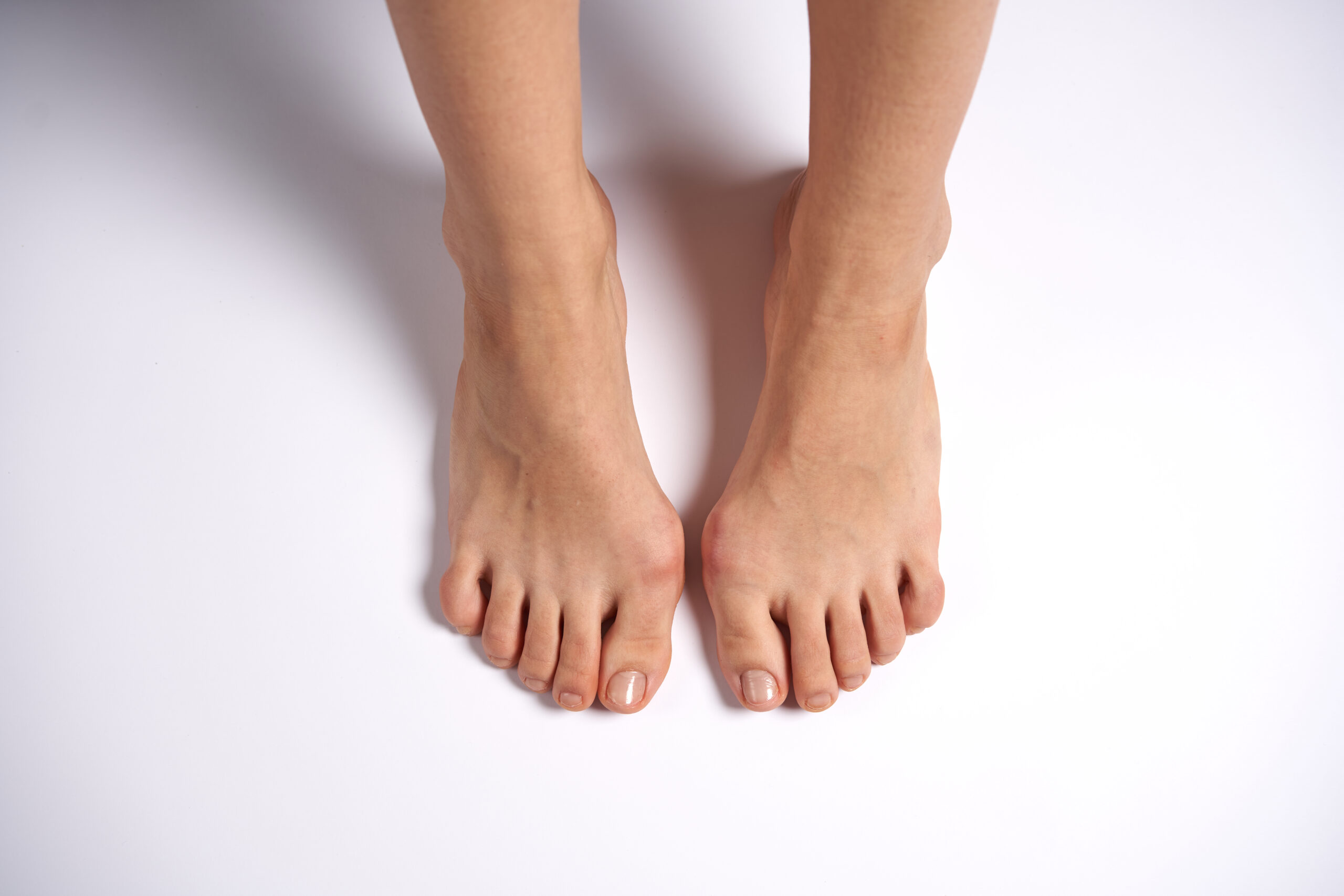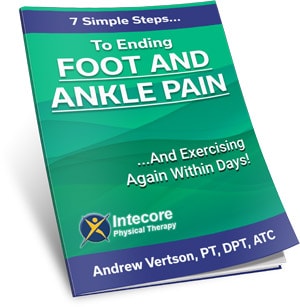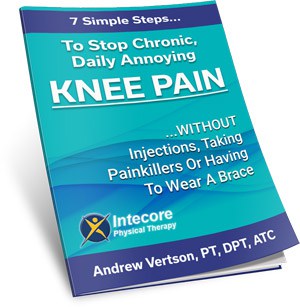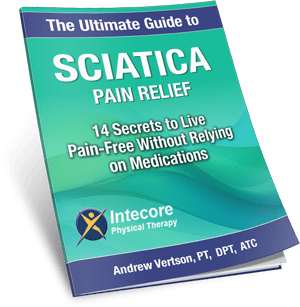
Have you ever kicked off your shoes at the end of the day only to find your feet looking puffier than usual?
Swollen feet can be annoying, uncomfortable, and sometimes even painful, but what’s actually causing it? Let’s walk through the most common reasons your feet might swell, what it means, and when it’s time to call in the experts.
More Posts Like This By Intecore Physical Therapy:
5 Ways To Alleviate Foot Pain When Walking
5 Simple Plantar Fasciitis Exercises for Effective Pain Relief
Table of Contents
What Causes Foot Swelling?
Swelling in your feet (also known as edema) happens when fluid builds up in the soft tissues. This can be due to something as simple as standing or sitting for too long—or it could signal an underlying health issue. Some of the most common causes include:
- Prolonged standing or sitting (think travel or desk jobs)
- Injury or overuse (like a sprain, fracture, or overworked muscles)
- Heat exposure
- Pregnancy
- Medical conditions (heart, kidney, or liver disease)
- Poor circulation
- Lymphedema (blockage in the lymphatic system)
- Side effects from medications (like blood pressure meds or steroids)
Understanding the cause is key to treating the swelling effectively.
Could My Daily Habits Be to Blame?
Yes! Sometimes swollen feet are simply your body’s response to lifestyle habits.
If you’ve been sitting at your desk all day, on your feet without breaks, or traveling, gravity can cause fluid to pool in your lower legs and feet.
Things like high-sodium diets, not drinking enough water, and wearing tight shoes or socks can also contribute to swelling.
Quick tip: Elevate your feet above heart level for 15-20 minutes and see if the swelling goes down. If it does, lifestyle factors are likely playing a role.
When Is Swelling a Sign of Injury?
Swelling is a natural part of the healing process after an injury, but it can also indicate something more serious.
If your foot swelling comes on suddenly and is accompanied by pain, bruising, redness, or difficulty walking, it could be:
- A sprain or ligament strain
- A stress fracture
- Tendonitis or soft tissue irritation
In these cases, don’t wait it out – book an appointment with a physical therapist who can assess the injury and help speed up recovery. Click here to chat with us and see if physical therapy is right for you.
Can Foot Swelling Be a Sign of a Medical Condition?
Definitely. While occasional swelling is usually harmless, persistent or unexplained swelling can be a warning sign.
Conditions to be aware of include:
- Heart disease or congestive heart failure
- Kidney or liver dysfunction
- Deep vein thrombosis (DVT) – especially if only one foot is swollen and it’s painful
- Chronic venous insufficiency – when your veins have trouble sending blood back to the heart
If you notice swelling along with other symptoms like shortness of breath, chest pain, or fatigue, it’s important to see a healthcare provider right away.
What Can I Do at Home for Swollen Feet?
Here are a few simple steps that can help relieve swelling at home:
- Elevate your feet above heart level
- Wear compression socks
- Stay active – gentle exercises like walking or ankle pumps help boost circulation
- Hydrate – water helps flush excess salt and fluid from your body
- Limit salty foods
- Massage your feet – or better yet, ask your PT for a targeted lymphatic massage
- Still swollen after trying these? That’s your cue to come in and see us.
When Should I See a Physical Therapist?
If your foot swelling keeps coming back, won’t go away, or is limiting your daily activities, a physical therapist can help you get to the root of the issue.
At Intecore Physical Therapy, we look beyond symptoms to treat the underlying cause – whether it’s circulation issues, biomechanics, or recovery from injury.
Our customized treatment plans often include:
- Hands-on therapy to reduce swelling
- Movement retraining to improve circulation
- Strengthening and balance work
- Education and tools for long-term relief
Ready to Get to the Bottom of Your Swollen Feet and Return to Life Pain Free?
Swollen feet might seem like a small thing, but they can tell us a lot about what’s going on inside your body. Don’t ignore persistent symptoms or try to push through the discomfort. Whether it’s a simple lifestyle tweak or a sign of something more, we’re here to help.
Click here to book your appointment today and let’s get you back on your feet comfortably!
Not ready to speak with us yet?
You can download our FREE foot and ankle pain guide which shares with you 7 simple steps to ending foot and ankle pain – click here to download it!

FAQs:
How do I get rid of swelling in my feet?
Start by elevating your feet above heart level for 15–20 minutes – this helps fluid drain back toward your heart. Gentle movement like walking or ankle pumps improves circulation, while compression socks can prevent fluid from pooling. Reducing salt intake, staying hydrated, and avoiding prolonged sitting or standing can also make a big difference. If swelling persists or worsens, it’s a good idea to see a physical therapist to rule out any underlying issues.
Does drinking water help with swollen feet?
Yes! It might seem counterintuitive, but drinking more water actually reduces swelling. When you’re dehydrated, your body holds onto extra fluid—especially in your lower limbs. Staying hydrated helps flush out excess sodium and keeps your lymphatic system working smoothly, both of which reduce swelling.
Is soaking in hot water good for swollen feet?
It depends. A warm soak can feel soothing and may help with swelling caused by muscle fatigue or overuse. But if your feet are swollen due to an injury, inflammation, or a medical condition (like heart or kidney issues), hot water might actually make it worse. Cool or contrast baths (alternating hot and cold) are often better for reducing swelling. When in doubt, check with a physical therapist or medical provider before soaking.
- How Many Hours of Sleep Do You Need for Recovery and Injury Prevention? - September 8, 2025
- Can Physical Therapy Help You Avoid Surgery? - August 1, 2025
- 7 Ways to Get Rid of Tension Headaches Naturally - July 1, 2025












